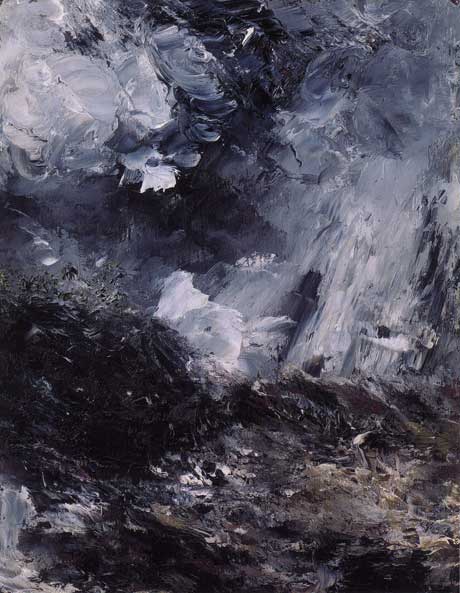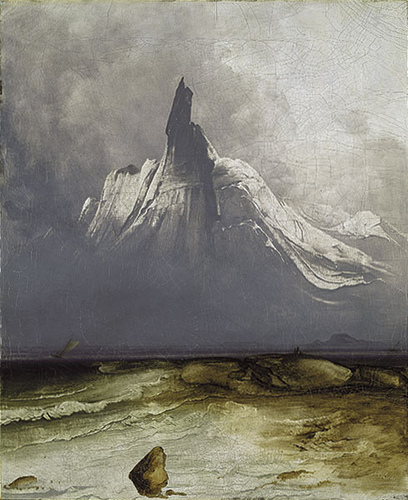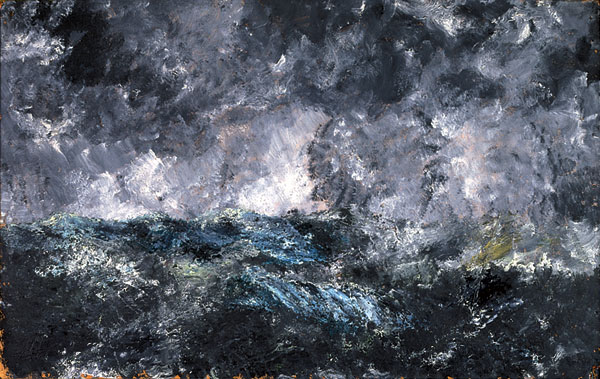August Strindberg was mainly known as a writer, but he was also a radical painter for his time. He viewed the landscape of his native Sweden as a reflection and metaphor for his own churning emotions and his diverse compositions of waves, rocks and skies done in different color palettes and moods can be interpreted as self-portraits and as such an insight into the mind of a genius and his own ability to establish a relation to his isolation, a kind of loneliness that recalls Bergman and which seems detached from the archetypal array of stock responses. In this respect Strindberg evokes Alfred Jarry as a creative force that spills its critical content across different mediums; the gloomy pessimism flowing into recessed corners of the psyche. It is in the more savage and primitive; symbolic snapshots of the psyche that Strindberg holds the most interest for viewers today. The unchained abandon must have had some influence on a Jackson Pollock or De Kooning.
Strindberg believed that chance played a central role in the creative process and he explored this concept in all his artistic work; a personal and radical approach at the time that would later form the core of artistic movements such as surrealism and Expressionism.Sue Prideaux:Strindberg was pursuing his painting very seriously; he admired Munch’s paintings and they worked together in the closest situation Munch ever got to collaboration. It was an intellectual rather than physical collaboration. They discussed theory and proposed subject matter but each was far too jealous to pick up a brush and apply it to the other’s canvas. Strindberg piloted the role of chance in creation as the new direction in art. It was part of a theory of the accidental, or theory of chance in the universe which was one of Nietzsche and Strindberg’s reactions to ‘the old positivism that had assured us that the universe held no secrets, that we had solved every riddle’. The irrational and the uncontrolled were the gate to the occult and the subconscious with all its strata and labyrinths; this was where the ultimate truth, the ‘psychology of the naked soul’could be found.Read More http://www.sueprideaux.com/pages/books/edvard_munch_behind_the_scream/extract.htm

1893. ---Strindberg was still drawn to nature at its most violent, and his seascapes of this time show dramatic collisions of water, wind and snow. Night of Jealousy, as its title suggests, is intended to convey mental torment as well as the fury of the elements. A dedication on the back of the painting reveals that he gave it to Frida as an engagement present. In Berlin, Strindberg and Frida had been part of a bohemian and sexually promiscuous group, and jealousies would inevitably have arisen. Strindberg was opposed to women’s liberation, and believed motherliness to be the greatest virtue in a woman. Paradoxically, he was always drawn to strong, emancipated career women.----click image for more
ADDENDUM:
Douglas Feuk:In an essay from 1894 called “Chance in Artistic Creation,” he describes the methods that he employs, speaking about his wish to “imitate […] nature’s way of creating.” This text is strangely prophetic, foreboding the automatic techniques of the 20th century. His method is to start more or less at random, trusting nature’s inherent desire for form (what he calls “matter’s drive towards representation”) to eventually make the picture develop out of the paint, almost by itself….

---the stringberg painting was an unbelievable surprise. i've obsessed over his paintings for years and never was able to see one in person until i turned the corner in the museum and there was the sea marn, which has always been one of my absolute favorites. a perfect compliment to munch's interior work; strindberg painted a bit like a mainiac and the interior frenetic activity of munch is all over the surface of strindberg's seascapes - the large cliff/rock is a ton of built up slapped on paint. it's completely haunting to see these dense grays and blacks created with a kind of manic energy---click on image for more....
…In his paintings there is always a “motif”—often stormy skies, agitated waves, perhaps a lonely rock by the sea. But these landscapes or seascapes are still half-embedded in the material, like a world in the process of being created. Boundaries and differences are fluid: Air might have the same density as stone, and the rock seems mysteriously fused with the water—as if they were all but different manifestations of the same matter. In fact, the tactile surface in Strindberg’s paintings is at times emphasized so much that not only does it provide an image of nature, it also, in part, gives the impression of being nature. In the painting High Sea, for example, there are sections that Strindberg has blackened with a burner, but also patches of a brownish-gray, rough structure that seem to be not so much painted as oxidized, or in other ways created by some elementary process of nature….

Strindberg. The Flying Dutchman.Alastair Sooke:Strindberg's approach to paint was antic, untutored and raw. His seascapes aren't rendered in a deathly, academic style. But his paintings remain much better known across Europe than here – which is surprising, given that one of Britain's artistic heroes was a formative influence. Despite their deep purples, bilious marines and blacks, Strindberg's paintings are indebted to the explosive whirlpools of light and water in the work of JMW Turner. Strindberg travelled to London in 1894 for the honeymoon of his second marriage, and probably saw Turner's work up-close on that visit. He later hailed Turner as one of his favourite artists. click on image for more...
Convinced that he had changed the development of painting in a progressive direction, Strindberg published his essay on chance and artistic production in a Parisian journal. And in his experimental photography from the same year, there are examples of images that are even more in line with what he called “natural art.” I am thinking of his “celestographs,” where the surfaces not only look weathered with an atmospherically-created patina, but even seem to have been made in physical collaboration with the weather. Read More:http://www.cabinetmagazine.org/issues/3/celesographs.php
Read More:http://www.art-newzealand.com/Issues21to30/chance22.htm
Read More:http://www.sueprideaux.com/pages/books/edvard_munch_behind_the_scream/extract.htm





 COMMENTS
COMMENTS
Hi there, enjoyed your notes on Strindberg – however, the painting of the ghostly mountain above the seashore is not by him but by Danish painter Peder Balke, and it’s titled “Stetind in Fog”, 1864. all best, as.
thanks for the correction Allan.
To previous correction: Peder Balke isn’t Danish, but Norwegian; the painting is one of many from the coast of Nordland.
Best wishes,
JD, Oslo